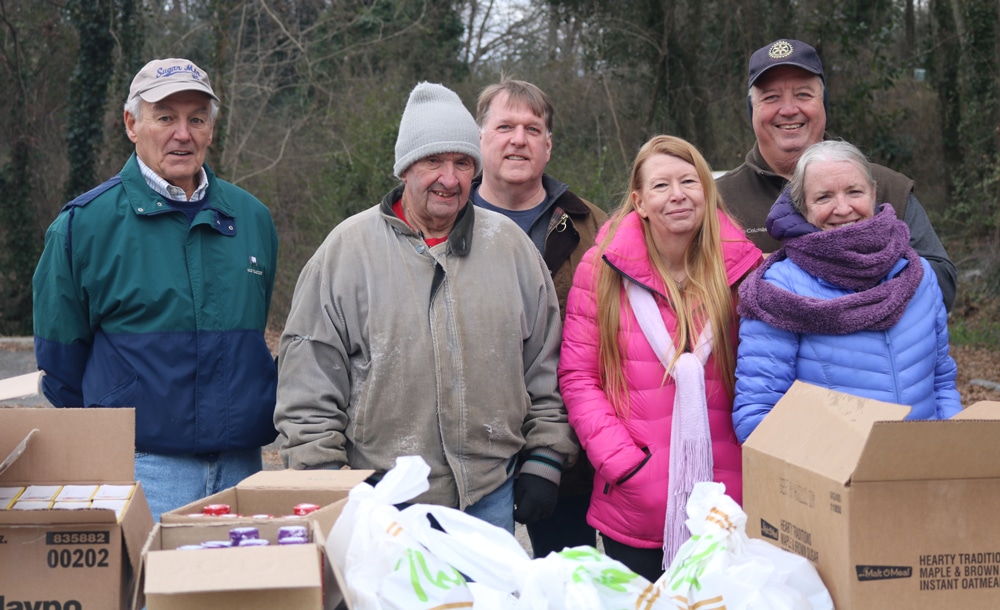Poverty Task Force Helps Families Prosper in Hart County
Print This Post
Members of the Poverty Task Force in Hart County Get Ready to load up cars with groceries.
by Diana St. Lifer
Hart County is fighting the battle against child poverty on several fronts, and the strategy is working. The rate of children living in poverty in the county in 2019 fell to 21.2%, the lowest it’s been since 2004. The rate was at a two-decade high in 2012 at 32.7% but has steadily declined ever since—a trend Patricia Werner, executive director of Hart Partners, hopes will continue.
“With persistence and continued collaborative work, the county could see child poverty rates fall below the state and national average,” said Werner. Georgia’s rate is 19.5%, while the national rate is 17%.
Hart Partners, a Georgia Family Connection Collaborative, partnered with the University of Georgia’s (UGA) Archway Program several years ago and formed a Poverty Task Force. Representatives from various agencies, organizations, businesses, and UGA examine poverty in the county from five vantage points: financial literacy, health and wellness, education, food insecurity, and housing and utilities.
“It all ties together,” Werner said. “You have to look at it as a circle and these are the pieces to the pie. When you put programming in place in all these areas, you have a much better chance of helping these families.”
“The group brings together interested community members and local stakeholders to talk about helping families in poverty by addressing the issues,” said Rosanna Cruz-Bibb, the Archway Professional for Hart County who oversees the Poverty Task Force.

Service representatives from health care, education, and nonprofits are at the table during meetings. The ability to bring university resources, including students and faculty, into the conversation is key, as well as connecting the group with community programs. “The Task Force brings the doers to the table,” Cruz-Bibb said.
A family of two adults and two children with an annual income below $25,926 was considered in poverty in 2019. “We have a lot of families in Hart right about there,” Werner said. “It doesn’t take much to push a family to poverty level.”
Located in the northeastern part of the state with a population just over 26,000, Hart County is home to young families as well as retirees who enjoy the tranquility of Lake Hartwell and one of the lowest property tax rates in the state.
“When it comes to income, we’re separated,” Werner said. “There are the wealthy folks who moved here after retiring from successful careers, and then you have the young parents who are struggling. While our median income is around $43,000, the reality is worse than the numbers show because of the disparity of incomes between young families and retirees.”
Between 2015 and 2019, more than 1,100 families with children (38.6%) had annual incomes of less than 150% of the federal poverty threshold—the lowest rate Hart’s seen since 2008-2012.
Part of that success is the improved job market, thanks to the opening of Nestle Purina and several other manufacturing companies. The 3.5% unemployment rate in 2019 was the lowest it’s been in more than two decades. “We’ve made good progress in that area thanks to these factory jobs,” Werner said. “A lot of our young parents are working in these plants.”

Hart Partners, Inc. Executive Director Patricia Werner chats with a community member.
The challenge, however, is affordable housing. “To rent a property here is more expensive than anywhere around us,” said Werner. “We don’t have a lot of young people moving into the county. Most families with small children went to high school here, then straight to work in a factory or on a family farm.”
“Hart County continues to be concerned with pockets of poverty and the Collaborative is working with partners to identify how to help residents in generational and situational poverty become self-sufficient,” said Toni Brown, regional manager for Georgia Family Connection Partnership. “And let’s not forget the working poor who don’t have governmental benefits but struggle to meet basic needs.”
The Distressed Communities Index published by the Economic Innovation Group combines seven economic indicators to determine a community’s standing relative to its peers:
- No high-school diploma
- Housing vacancy rate
- Adults not working
- Poverty rate
- Median income ratio
- Change in employment
- Change in establishments
“Economically distressed means high unemployment levels, low-income levels, and high poverty,” Brown said. “Hart County is mid-tier.”
According to the Annie E. Casey Foundation, poverty elevates a child’s risk of experiencing behavioral, social and emotional, and health challenges. Child poverty also reduces skill-building opportunities and academic outcomes, undercutting a young student’s capacity to learn and graduate from high school.
Werner has seen the positive affects a sliding child poverty rate has on other health and well-being indicators. “The biggest impact has been on the high-school graduation rate and students reading on grade level,” she said. “We’ve added a lot of nutrition programs so kids get the food they need, and we do very well in our low rate of students with missed days of school.”

The Poverty Task Force sparked the idea for an ongoing 10-week financial wellness course to help local citizens rise above poverty and benefit from long-term prosperity. The Hart County Industrial Building Authority, Hart College and Career Academy, and other local partners launched the project. “Those classes put parents in a better place to get better jobs to bring their families out of poverty,” Werner said.
The Poverty Task Force also initiated a Food Recovery Program in which local grocery stores, farmers, and restaurants donate food that would otherwise go unused. Once a week, a local restaurant donates pizzas that are taken to neighborhoods. To date, 33,587 pounds of food and 2,067 pizzas have been donated—which equates to feeding 4,306 families.

The Food Recovery Program was especially valuable when schools closed during the pandemic, considering 72% of children at Hartwell Elementary School receive free or reduced lunch.
“COVID-19 brought food insecurity and other issues to the forefront,” Werner said. “It’s affected the way we do our work because we’re not able to carry out some programs we were doing pre-pandemic.”
Challenges, however, don’t stop the work from getting done. “I’ve been with Family Connection for more than 20 years,” Werner said. “Without an organization like ours, which has roots in the community and partnerships like we have with Archway, a lot of these programs wouldn’t exist. You must have the entire community working toward the same goal. There needs to be dedicated people, and we have that in Hart County.”
To learn more about Hart Partners and the Poverty Task Force, contact Patricia Werner at hartpartners@yahoo.com.
Read and share Expanding Our Perspective, Unlocking Our Potential—Georgia Family Connection’s 30-year impact report.
Contact:
Krystin Dean
GaFCP Communications Specialist
706-897-4711
krystin@gafcp.org
Follow us on Twitter: @gafcpnews
Connect with us on Facebook.
